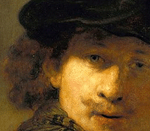
"The Three Marys at the Tomb"
Annibale Carracci ( November 3, 1560 – July 15, 1609) was an Italian painter and instructor, active in Bologna and later in Rome. Along with his brother and cousin, Annibale was one of the progenitors, if not founders of a leading strand of the Baroque style, borrowing from styles from both north and south of their native city, and aspiring for a return to classical monumentality, but adding a more vital dynamism. The tradition of Italian Renaissance painting and the mature Renaissance artists like Raphael, Michelangelo, Correggio, Titian and Veronese are all painters who had a considerable influence on the work of the Carracci, in his use of colours. Carraci laid the foundations for the birth of Baroque painting. The preceding sterile Mannerist style had its recovery now in the Baroque painting in the early sixteenth century, succeeding in an original synthesis of the many schools.
This painting is one of the best examples of Annibale's synthesis of the artists then active in Rome, as also seen in The Loves of the Gods frescoes around 1600[3] In this work we specifically see the influence of classical sculpture and Raphael, particularly the latter's cartoons for the Vatican tapestries.[3] It is typical of his style in Rome but still linked to his early style - Mary Magdalene's red and gold dress is almost identical to Good Fortune or Happiness in his Allegory of Truth and Time (Hampton Court), painted about fifteen years earlier